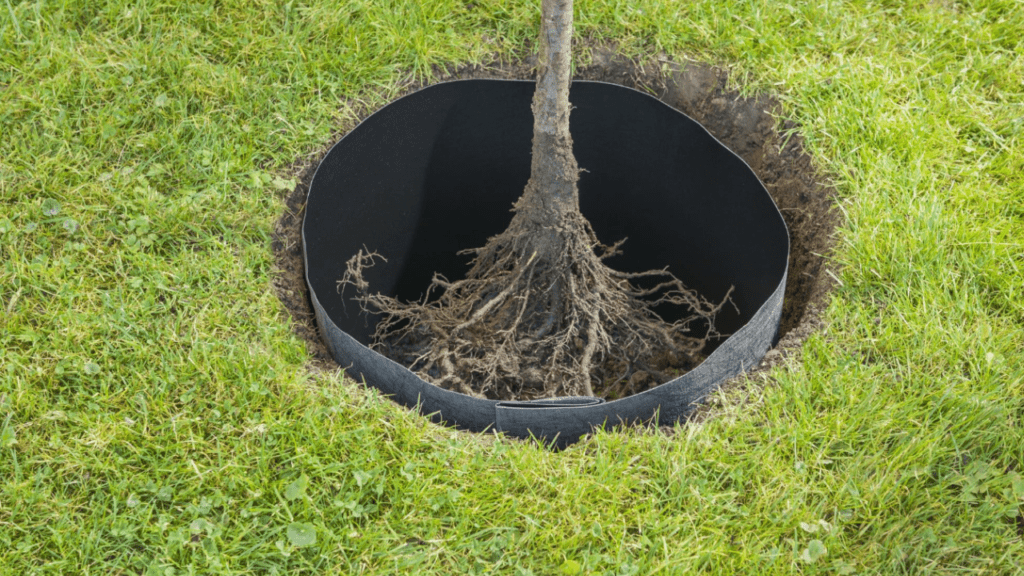
Root Barrier Solutions: Safeguard Your Trees and Property with Ease
Root barriers are an essential tool for protecting your trees and property from potential damage caused by invasive root systems. In this article, we will discuss the benefits of using root barrier solutions, the different types available, and how to effectively install them to safeguard your trees and property with ease. Whether you are a homeowner or a landscaper, understanding the importance of root barriers and how to utilize them effectively is crucial for maintaining the health and integrity of your property. Let’s dive into the world of root barrier solutions and learn how they can benefit you.
Trees are not just decorative elements in our landscapes; they’re essential for maintaining a healthy environment and providing numerous benefits, from improving air quality to reducing energy costs. However, as trees grow, their roots can sometimes pose challenges, particularly when they encroach upon structures like sidewalks, driveways, and buildings. This is where root barrier solutions come into play.
Root barriers are physical barriers installed underground to redirect or contain the growth of tree roots. These barriers help prevent root intrusion into unwanted areas, reducing the risk of damage to property and infrastructure. Here’s everything you need to know about root barriers and how they can safeguard your trees and property.
Table of Contents
ToggleThe Importance of Root Barriers for Tree and Property Protection
Trees are invaluable assets in our landscapes, providing shade, beauty, and numerous environmental benefits. However, as trees grow, their roots can sometimes pose challenges, particularly when they encroach upon structures like sidewalks, driveways, and buildings. In such cases, root barriers play a crucial role in protecting both trees and property. Here’s why root barriers are essential for tree and property protection:
Prevent Property Damage
Tree roots have a remarkable ability to seek out water and nutrients, often extending far beyond the canopy of the tree. While this is essential for the tree’s health, it can lead to problems when roots infiltrate underground utilities, foundations, and other structures. Root barriers act as a physical barrier, preventing root intrusion into these sensitive areas and reducing the risk of costly damage.
Preserve Tree Health
While root barriers restrict the lateral growth of tree roots, they do not necessarily harm the tree itself. In fact, properly installed root barriers can promote healthier root development by preventing root circling and girdling. By redirecting root growth away from compacted soil or areas with poor drainage, root barriers help maintain optimal growing conditions for trees.
Reduce Maintenance Costs
Dealing with invasive tree roots can be a costly and time-consuming endeavor. Root barriers provide a proactive solution to root-related issues, reducing the need for frequent repairs and maintenance. By investing in root barriers, property owners can save both time and money in the long run.
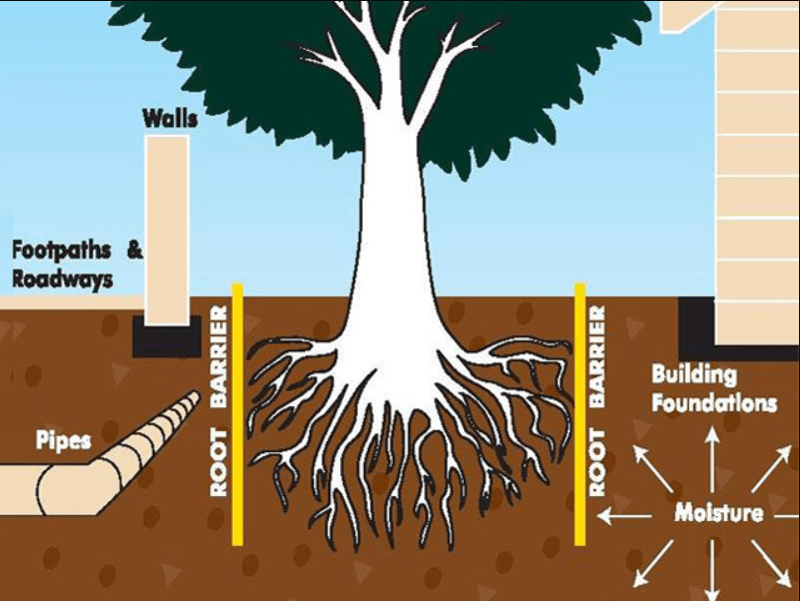
Protect Landscaping Features
In addition to protecting structures, root barriers can also safeguard landscaping features such as flower beds, turf areas, and hardscape elements. By preventing root encroachment into these areas, root barriers help preserve the aesthetic appeal of outdoor spaces and maintain the integrity of landscaping designs.
Promote Sustainable Landscaping
Root barriers are an essential component of sustainable landscaping practices. By managing tree roots in a proactive and environmentally responsible manner, root barriers help minimize disruption to the surrounding ecosystem. This promotes the long-term health and vitality of both trees and the broader landscape.
Types of Root Barriers: Physical and Chemical
The extensive root systems of trees, while essential for their health, can sometimes become unwelcome guests in our carefully designed landscapes. To protect our property from unwanted root intrusion, root barriers offer a valuable solution. But with two main categories – physical and chemical – understanding the distinctions is crucial for making the right choice.
Physical Root Barriers: A Mechanical Approach
Physical root barriers act as a physical wall, creating a barrier that redirects or prevents root growth in unwanted areas. These are typically made from durable materials like:
- Polyethylene: A popular choice due to its cost-effectiveness, flexibility, and puncture resistance.
- Polypropylene: Offering superior strength and longevity compared to polyethylene, making it ideal for larger or more aggressive root systems.
- Geocomposites: These combine textiles with other materials like polyethylene, providing additional strength and tear resistance.
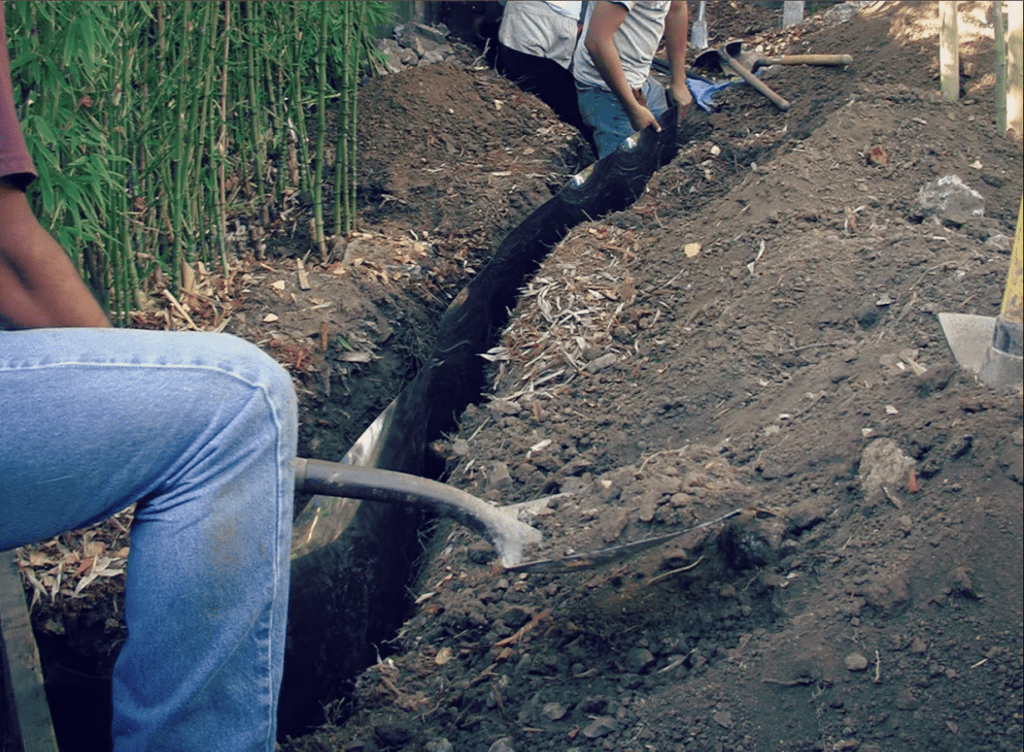
Benefits of Physical Root Barriers:
- Non-Invasive: They pose no harm to the tree itself, allowing it to thrive while protecting your property.
- Long-Lasting: Made from durable materials, physical barriers offer a long-term solution with minimal maintenance required.
- Versatility: Available in various sizes and thicknesses to suit different needs, from protecting foundations to safeguarding underground utilities.
- Environmentally Friendly: They do not introduce harmful chemicals into the soil.
Chemical Root Barriers: A Targeted Approach
Chemical root barriers, on the other hand, utilize herbicides to deter or control root growth. These typically come in two forms:
- Soil Sprays: Applied directly to the soil around the desired protected area, these sprays contain herbicides that inhibit root growth.
- Root-Tip Barriers: These are mesh socks impregnated with herbicides that are placed around existing tree roots to prevent further growth in a specific direction.

Important Considerations for Chemical Root Barriers:
- Selectivity: Ideally, the chosen herbicide should target only tree roots and minimize impact on surrounding vegetation.
- Environmental Impact: Chemical herbicides can potentially harm desirable plants or seep into groundwater sources. Careful selection and application are crucial.
- Temporary Solution: The effectiveness of chemical root barriers diminishes over time as the herbicide breaks down in the soil. Re-application may be necessary.
- Regulations: The use of certain herbicides may be restricted in some regions. Always check local regulations before using chemical root barriers.
Choosing the Right Root Barrier:
The ideal solution depends on various factors:
- Tree Size and Maturity: Larger trees require a more robust barrier, either a thicker physical barrier or a stronger herbicide formulation.
- Protection Area: Consider the size of the area you want to safeguard.
- Environmental Concerns: If minimizing environmental impact is a priority, physical barriers are the preferred choice.
- Regulations: Local regulations may restrict the use of certain chemical herbicides.
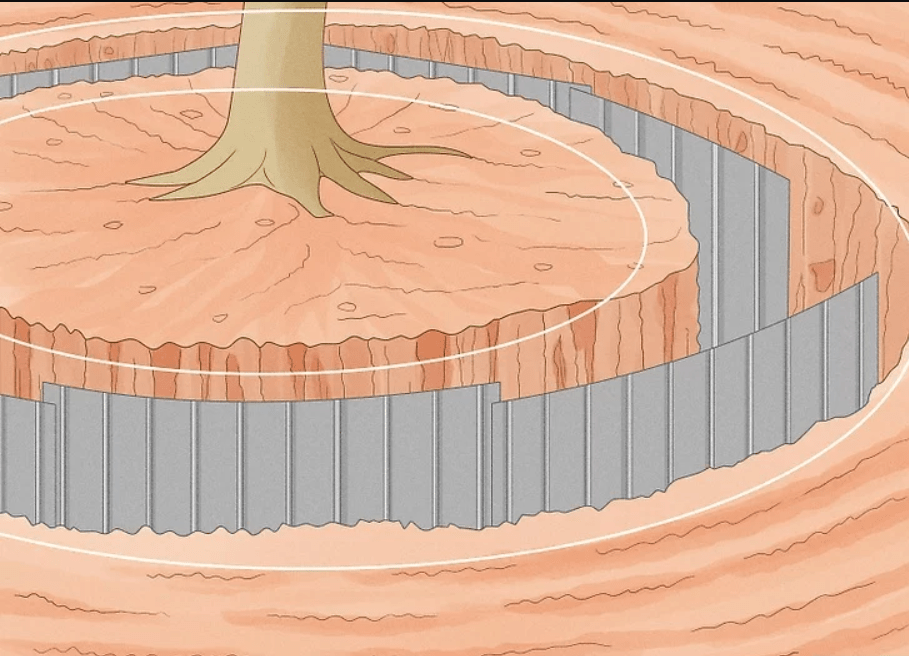
Selecting the Ideal Root Barrier for Your Requirements
Tree roots are a double-edged sword. They provide essential support and nourishment for trees, but their relentless growth can wreak havoc on your property. To safeguard both your trees and your structures, root barriers offer a valuable solution. However, with different types available, choosing the right one requires careful consideration. Here’s a breakdown to help you navigate the options and select the perfect root barrier for your needs:
Understanding Your Needs:
Before diving into specific barriers, take stock of your situation:
- What are you protecting? Are you safeguarding a foundation, driveway, walkway, or underground utilities?
- What type of tree are you dealing with? Consider the size, maturity, and root aggressiveness of the tree.
- What is your budget? Root barriers range in price depending on material, thickness, and size.
- Environmental concerns? Do you prioritize a non-invasive solution that minimizes environmental impact?
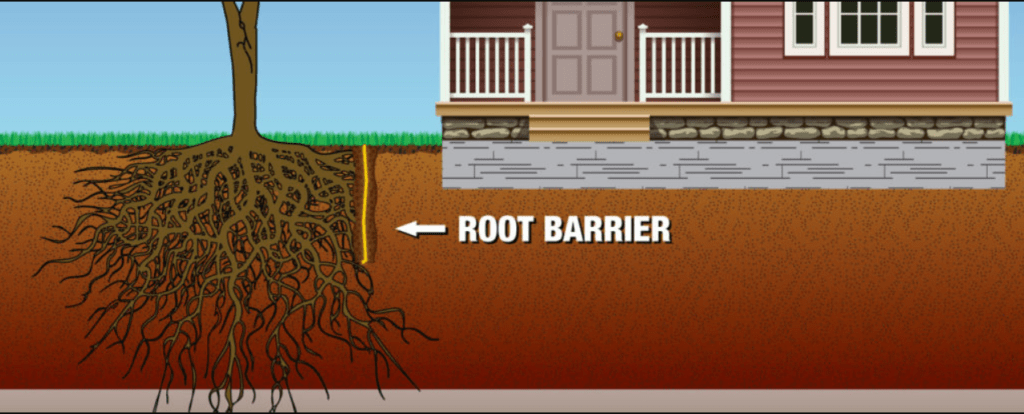
The Two Main Contenders: Physical vs. Chemical Barriers
Physical Root Barriers
- Function: These act as a physical wall, redirecting or preventing root growth in unwanted areas.
- Materials: Typically made from durable materials like polyethylene, polypropylene, or geocomposites.
- Benefits:
- Non-invasive: Safe for trees while protecting your property.
- Long-lasting: Minimal maintenance required.
- Versatile: Available in various sizes and thicknesses for different needs.
- Environmentally friendly: No harmful chemicals.
- Drawbacks: May require professional installation for larger projects.
Chemical Root Barriers
- Function: These utilize herbicides to deter or control root growth.
- Forms: Soil sprays applied directly to the soil or root-tip barriers placed around existing roots.
- Benefits:
- Can be effective for established trees with aggressive root systems.
- Drawbacks:
- Environmental impact: Herbicides can harm desirable plants or pollute groundwater.
- Temporary solution: Requires re-application over time.
- Regulations: Use of certain herbicides may be restricted in some areas.
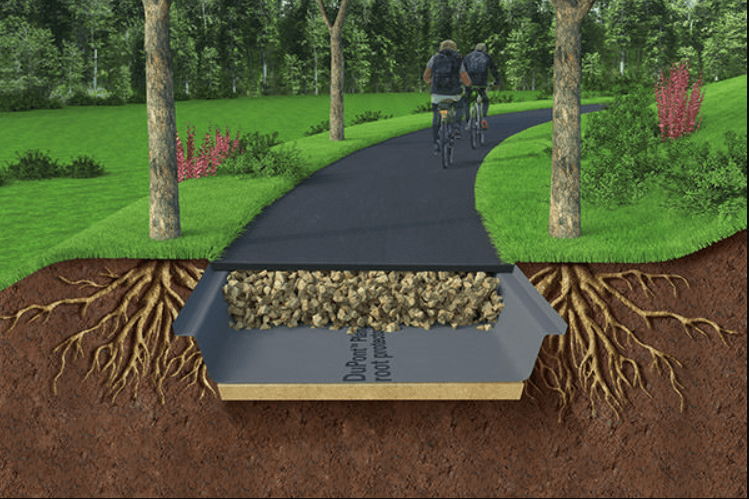
Choosing the Right Barrier:
For most situations, physical root barriers are the preferred choice due to their:
- Safety for trees: No harmful chemicals involved.
- Long-lasting effectiveness: Requires minimal maintenance.
- Environmental friendliness: No risk of contaminating soil or water.
However, consider chemical root barriers if:
- You have a mature tree with a very aggressive root system. Physical barriers might not be strong enough.
- Budget is a major concern. Chemical root barriers can be cheaper upfront (though reapplication costs may negate this in the long run).
Additional Considerations:
- Size and thickness: The size and thickness of the barrier should correspond to the size and maturity of the tree, as well as the area you want to protect.
- Professional installation: While DIY installation is possible for smaller projects, consulting a professional landscaper for larger projects or complex situations is recommended. They can ensure proper installation and minimize the risk of root damage.
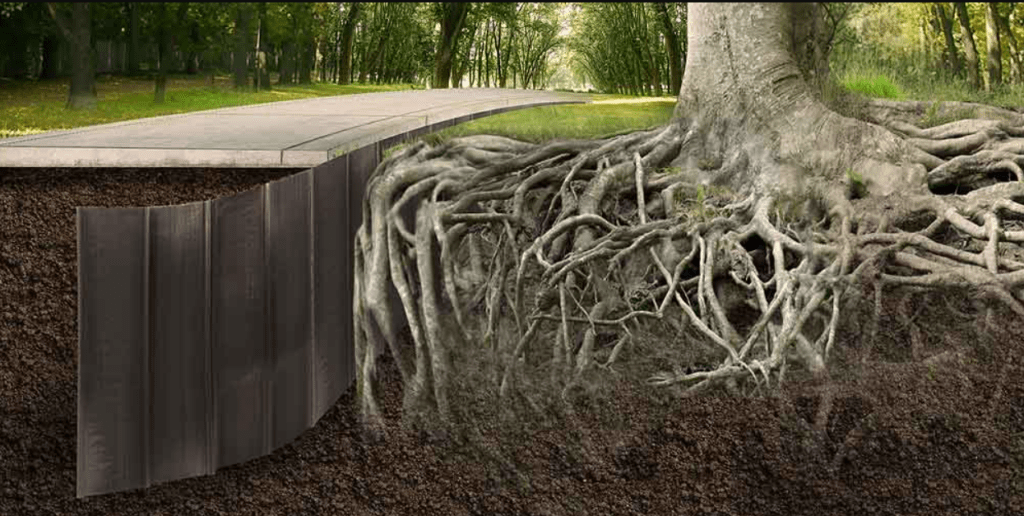
Installation Process for Root Barriers
Tree roots are a vital part of a healthy landscape, but their expansive growth can sometimes pose a threat to sidewalks, driveways, foundations, and even underground utilities. Root barriers offer a reliable solution, but proper installation is crucial for their effectiveness. Here’s a step-by-step guide to navigate the root barrier installation process:
Preparation is Key
- Assess the Situation: Before diving in, identify the specific area you want to protect and the type of tree you’re dealing with. Understanding the root system’s size, maturity, and aggressiveness will help determine the appropriate barrier type and size.
- Gather Your Supplies: Procure the chosen root barrier material, ensuring it’s appropriate for your needs (size, thickness). You’ll also need tools like a shovel, utility knife, heavy-duty work gloves, safety glasses, tape (optional), and landscape fabric (optional). Consulting a professional landscaper for material recommendations and guidance is advisable, especially for complex projects.
Trench Time
- Digging the Trench: Mark the perimeter of the area you want to protect. Using a shovel, carefully dig a trench along the marked lines. The depth of the trench is crucial. Aim for a depth that effectively disrupts the tree’s desired root growth path. Refer to the specific root barrier manufacturer’s recommendations for depth based on the chosen barrier and tree species.
- Creating a Clean Slate: Once the trench is dug, remove any loose soil, rocks, or debris from the bottom and sides. A clean and even surface ensures optimal barrier placement.
Installing the Root Barrier
- Unfurling the Barrier: Carefully unroll the root barrier along the length of the trench. Ensure the barrier extends vertically at least a few inches above the intended ground level. Overlap the ends of the barrier by at least 12 inches and secure them with strong tape (optional) for a continuous barrier.
- Securing the Barrier (Optional): For additional stability, particularly in areas with loose soil, you can secure the top edge of the barrier to the ground using landscape staples or spikes designed for this purpose.
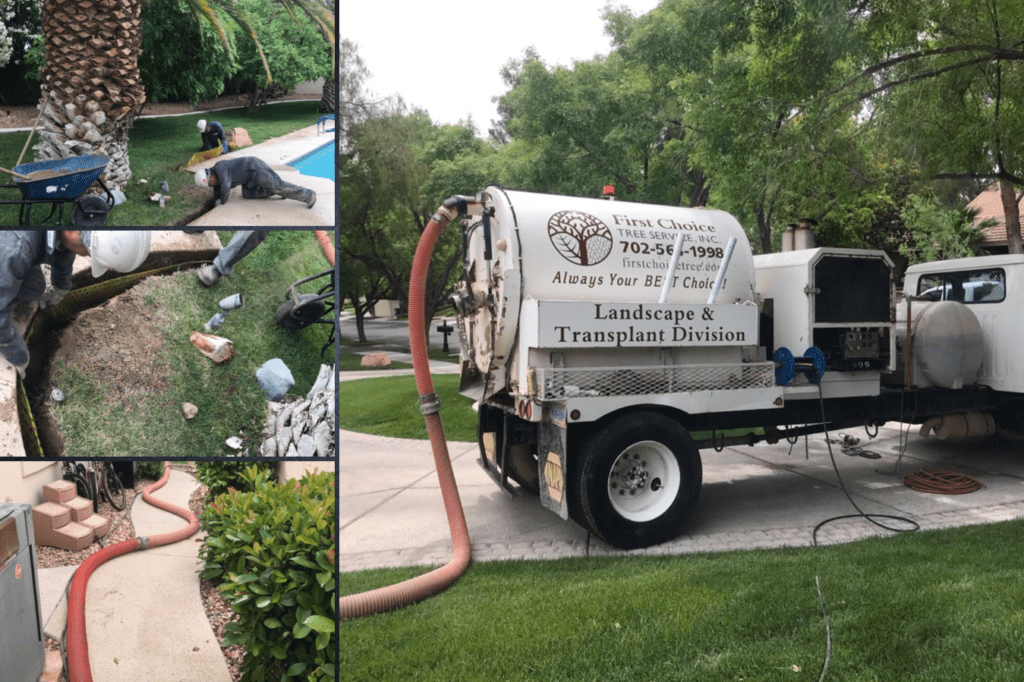
Backfilling the Trench
- Filling it Up: Carefully backfill the trench with the previously removed soil. Compact the soil gently but firmly as you fill to eliminate air pockets and ensure proper stability.
Finishing Touches
- Leveling the Ground: Once the trench is filled, level the ground to match the surrounding landscape. You can add topsoil or mulch as needed to create a finished look.
- Monitoring and Maintenance: While root barriers are a long-term solution, occasional monitoring is recommended. Inspect the barrier for any signs of damage or root pushing against it. Address any issues promptly to ensure continued effectiveness.
Additional Considerations:
- Professional Installation: For complex projects involving large trees or deep trenches, professional installation by a qualified landscaper is highly recommended. They possess the expertise and equipment to handle the job efficiently and minimize the risk of root damage during the process.
- Calling Before You Dig: Before digging any trenches, especially near your property line, it’s crucial to contact your local utility locating service to mark any underground utilities to avoid accidental damage.
Maintenance and Monitoring of Root Barriers
Root barriers offer a reliable solution for protecting your property from unwanted tree root intrusion. However, like any other landscape element, they require occasional maintenance and monitoring to ensure continued effectiveness. Here’s a breakdown of key steps to keep your root barrier functioning optimally:
Monitoring for Signs of Trouble
- Visual Inspection: Regularly inspect the protected area for any signs of root pushing against the barrier. Look for cracks, bulges, or any warping of the barrier itself.
- Soil Movement: Pay attention to the soil around the barrier, especially near the edges. Uneven settling or raised areas could indicate root activity attempting to bypass the barrier.
- Tree Health: While root barriers are designed to be safe for trees, any sudden changes in tree health, such as wilting or stunted growth, could indicate root damage during installation or a deeper issue requiring professional evaluation.
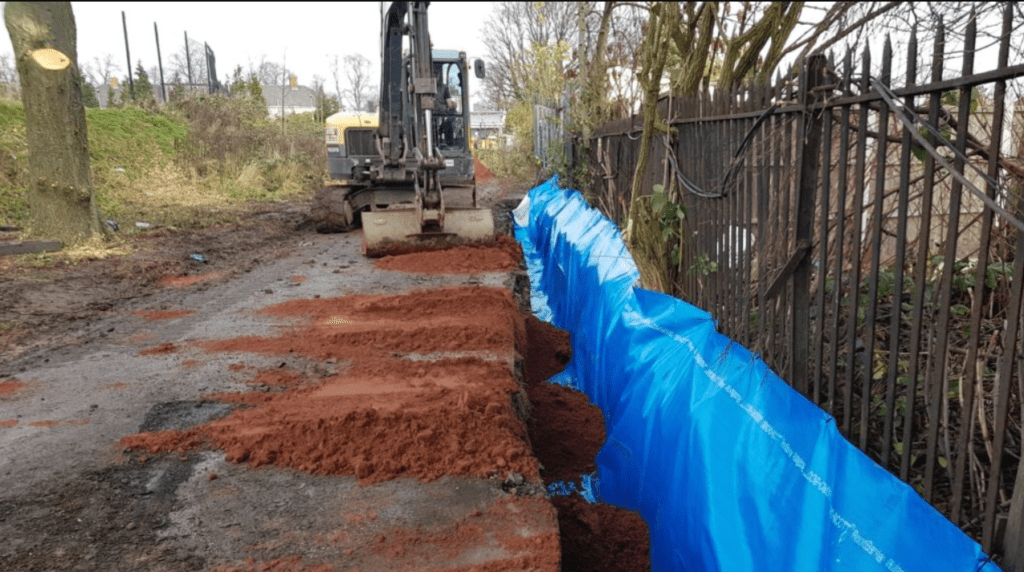
Frequency of Monitoring
The frequency of monitoring depends on several factors:
- Tree Species: Trees with aggressive root systems may require more frequent checks.
- Age of the Barrier: New installations warrant closer monitoring in the initial years as the tree adjusts to the presence of the barrier.
- Initial Root Activity: If you noticed significant root activity during installation, more frequent monitoring might be necessary in the following months.
General Maintenance Recommendations
- Addressing Minor Issues: If you discover minor root pushing against the barrier, addressing it promptly is crucial. You can carefully prune any roots pushing against the barrier using sharp pruning shears or a saw. However, for extensive root growth or situations beyond your comfort level, consult a certified arborist.
- Topsoil and Mulch: Over time, erosion or settling can expose the top edge of the root barrier. Maintain a proper layer of topsoil and mulch around the protected area to conceal the barrier and prevent exposed edges from becoming vulnerable to root intrusion.
- Professional Assistance: For complex situations involving significant root growth or concerns about potential damage to the tree, don’t hesitate to seek help from a professional arborist.
Additional Tips:
- Keep a Record: Maintain a simple record of your inspection dates and any observations or actions taken. This can be helpful in tracking changes and informing future monitoring schedules.
- Seasonal Monitoring: Consider conducting a more thorough inspection in the spring, before new growth begins, and another in the fall, after the growing season.
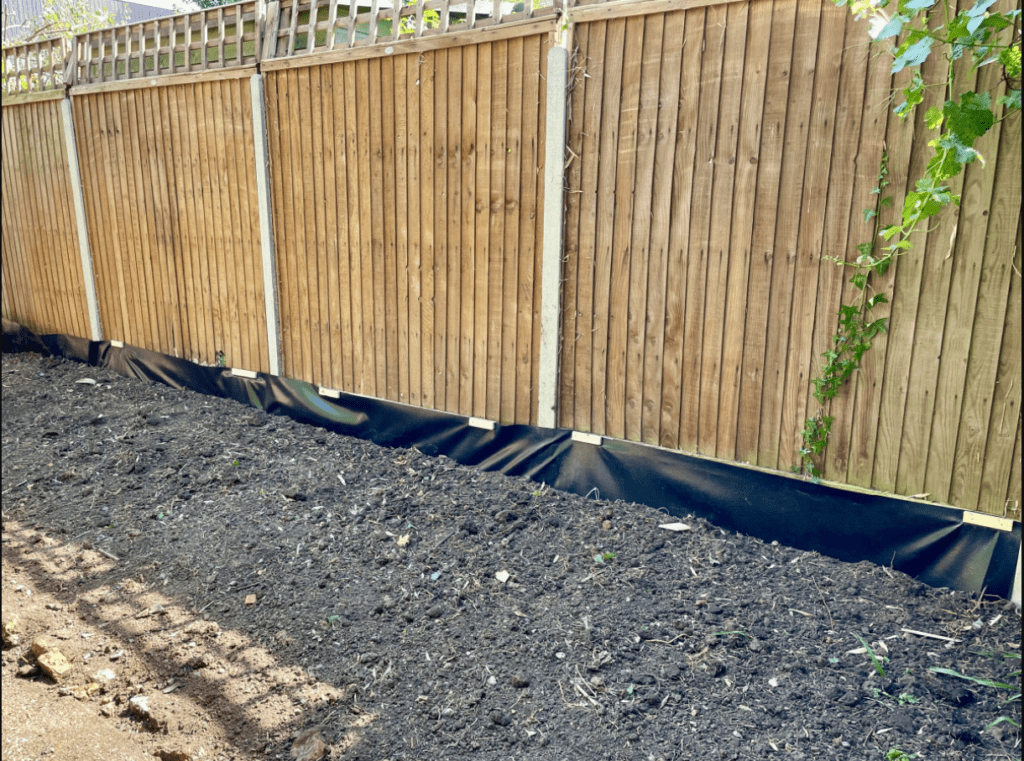
Benefits of Using Root Barriers for Tree and Property Protection
Trees are majestic additions to our properties, offering shade, beauty, and a connection to nature. However, their extensive root systems can sometimes become a destructive force, wreaking havoc on foundations, driveways, walkways, and even underground utilities. This is where root barriers come in, playing a crucial role in safeguarding both your trees and your property. Here’s a closer look at the multifaceted benefits they provide:
Safeguarding Your Property
- Shielding Foundations: Tree roots can exert immense pressure, causing cracks and potentially compromising the structural integrity of your foundation. Root barriers create a barrier, preventing roots from encroaching on this critical area and saving you from costly repairs down the line.
- Protecting Infrastructure: Driveways, walkways, and patios are all susceptible to root damage. Root barriers prevent unwanted root growth, ensuring a smooth and even surface for years to come.
- Underground Utility Defense: Tree roots are notorious for seeking out moisture, and underground pipes often become unsuspecting victims. Root barriers act as a shield, preventing root infiltration and the resulting blockages and sewage backups.
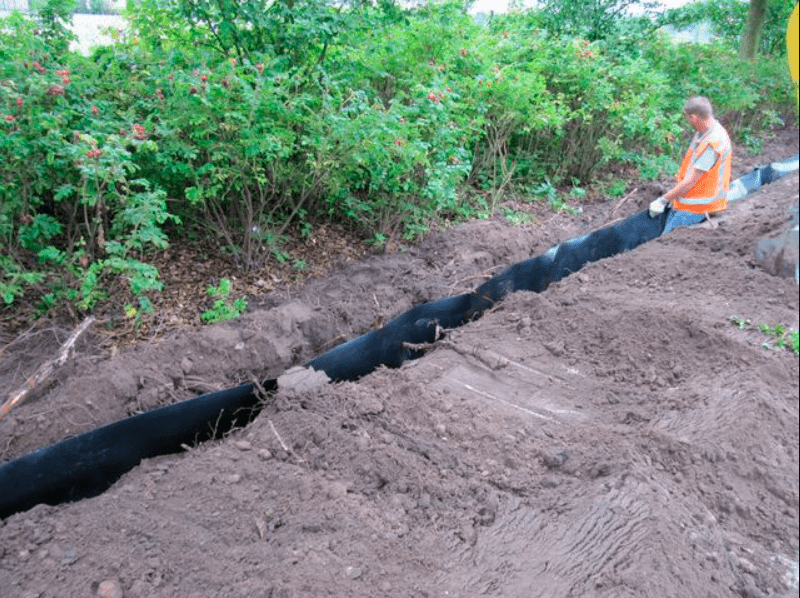
Preserving the Health of Your Trees
- A Non-Invasive Solution: Unlike harsh chemicals, root barriers offer a safe and environmentally friendly way to manage root growth. They allow trees to flourish while protecting your property.
- Minimized Root Disruption: Properly installed root barriers minimize root disruption during installation, reducing stress on the tree and promoting healthy growth.
- Long-Term Tree Health: By preventing roots from expending energy trying to navigate through unwanted areas, root barriers can indirectly contribute to the overall health and longevity of your trees.
Additional Advantages:
- Versatility: Root barriers can be used in various applications, from protecting new construction projects to safeguarding existing structures near mature trees.
- Durability: Made from long-lasting materials, properly installed root barriers offer a long-term solution with minimal maintenance required.
- Cost-Effectiveness: While there is an upfront cost, root barriers can prevent expensive repairs caused by root damage in the long run.
In conclusion, using root barrier solutions is a cost-effective and efficient way to protect your trees and property from potential damage. Whether you are dealing with invasive roots, soil erosion, or property damage, installing a root barrier can provide a long-term solution to safeguarding your landscape. With a variety of options available, including physical barriers and chemical treatments, you can find the right solution to fit your specific needs. By taking proactive measures to protect your trees and property, you can ensure the health and longevity of your landscape for years to come.
Frequently Asked Question (FAQ)
Root barriers are physical barriers installed underground to redirect or contain the growth of tree roots. They are typically made from durable materials such as plastic, rubber, or metal.
Root barriers prevent tree roots from encroaching upon structures like sidewalks, driveways, and buildings, reducing the risk of damage. By redirecting root growth away from these areas, root barriers help preserve both tree health and property integrity.
Tree roots can infiltrate underground utilities, foundations, and other structures, leading to costly damage and repairs. They can also disrupt landscaping features such as flower beds, turf areas, and hardscape elements.
While root barriers restrict lateral root growth, they do not harm the tree itself. In fact, properly installed root barriers can prevent root circling and girdling, promoting healthier root development and overall tree vitality.
Root barriers can be used with most tree species, but the suitability may vary depending on factors such as tree size, root growth characteristics, and soil conditions. Consulting with a professional arborist or landscaper is recommended to determine the best approach for your specific situation.
Root barriers are typically installed vertically into the soil around the perimeter of trees or other sensitive areas. The depth and distance of installation depend on factors such as tree species and soil conditions.
Yes, regular inspection and maintenance of root barriers are essential to ensure their ongoing effectiveness. This includes checking for signs of root penetration or barrier damage and making any necessary repairs or adjustments.
Yes, root barriers can be installed around existing trees to mitigate root-related issues. However, the effectiveness of retrofitting root barriers may vary depending on the size and age of the tree, as well as the extent of existing root growth.
